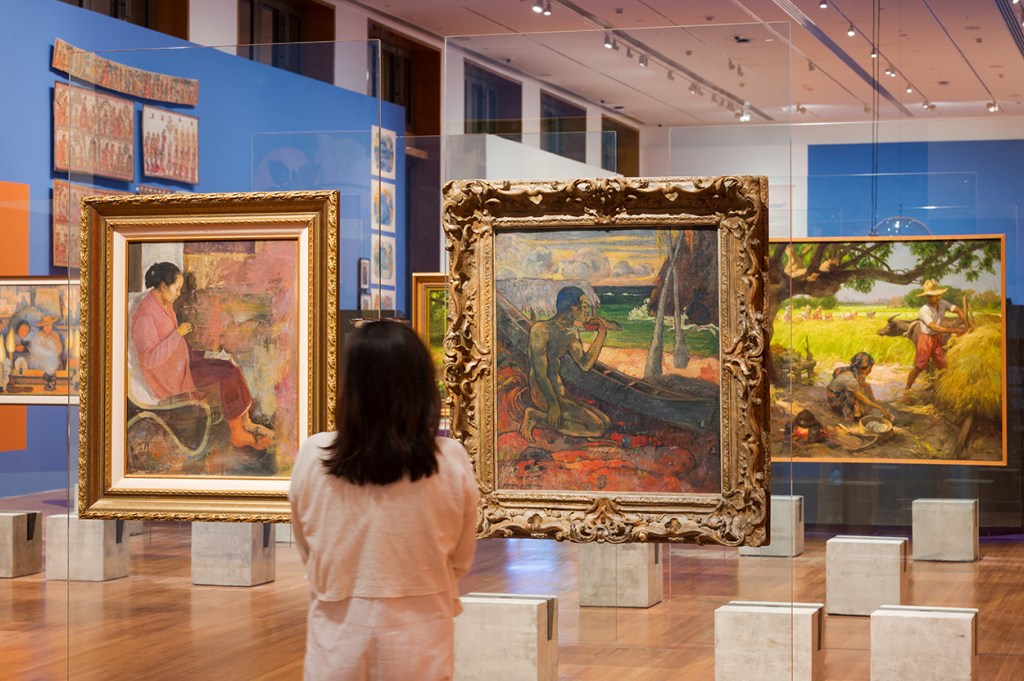Rumor has it that, somewhere in New York City, sometime during the mid-twentieth century, the Mexican muralist Diego Rivera had a chance meeting with the Filipino painter Victorio Edades. This storied encounter centered around a formative conversation about the political power of murals, wherein both artists chatted with great gusto about how they’d paint their respective revolutions. While there is no real evidence as to whether this meeting actually took place, the tropical alliance the story suggests galvanized artists for generations to come.
And so, a mural Edades painted with Galo B. Ocampo and Carlos “Botong” Francisco— Mother Nature’s Bounty (1935)—opens “Tropical: Stories from Southeast Asia and Latin America” at the National Gallery Singapore. The show surveys shared formal and political sensibilities in art from the two tropical regions, all made in the twentieth century. This trio painted the Philippine revolution, borrowing motifs from the Mexican muralists with whom they share a colonizer: Spain. Both groups painted scenes packed with workers, whose bodies are rendered sturdy and statuesque, forming all-over compositions.
Victorio C. Edades, Galo B. Ocampo and Carlos
“Botong” Francisco: Mother Nature’s Bounty
Harvest, 1935.
©Armin Christopher E. Cuadra
This mural hangs near Pobre Pescador (Poor Fisherman), 1896, by Paul Gauguin—the notorious French painter of Tahitian scenes. Gauguin, “Tropical” argues, planted stereotypical images of the tropics in the minds of many—images of a peaceful paradise, endless summer, lazy natives, and free love. That last one, “free love,” is a grating contortion, coming from a man whose muse was his child bride. But instead of canceling Gauguin fully, “Tropical” positions his work as the problem so many tropical artists were working against. Eat Pray Love, the bestselling memoir Elizabeth Gilbert wrote about finding herself in Bali in the wake of a divorce, is included for similar reasons in a library of tropical literature presented as part of the show.
Paul Gauguin: Pobre Pescador (Poor Fisherman), 1896.
Eduardo Ortega
Many paintings here contend with the way pastoral imagery was entwined with various projects of colonialism, which used images of verdant land brimming with untapped resources as justifications for occupation. A group of these landscapes is hung on apparatuses designed by the Brazilian architect Lina Bo Bardi, an icon of tropical modernism who, for a museum she designed in São Paulo, placed paintings on clear vertical planks stuck in blocks of concrete. She wanted to arrange works not linearly, but in what she called “a marvelous entanglement.” On these devices, labels are placed behind the paintings rather than next to them, so walking about, you’re forced to delay categorizing the mixture of works into their respective regions. Instead, you’re left attending to their affinities—chief among them their jewel-toned palettes, with rusty oranges and royal blues extending from verdant emeralds.
Mostly, these works refute ideas of untouched lands full of lazy natives with scenes showing workers, bustling streetscapes, and active human beings. Vibrant street scenes by S. Sudjojono, a founder of Indonesian modernism, stand out: he insisted on the political power of painting, always reminding people that the medium was no master’s tool, since it began not in Europe, but rather Egypt.
The most provocative pastoral riff is by Semsar Siahaan, whose 9-foot version of Manet’s Olympia shows a nude blonde woman lounging in sunglasses and heels, sipping from a coconut decorated with flowers. In Siahaan’s rendition from 1987, dozens of locals surround her, flocking from the surrounding land to dote, point, or stare. A brown foot extends from under her bed, right next to her suitcase, as if the man who carried her luggage also offered himself as an ottoman. Another work by Siahaan is a suite of sculptures the Indonesian artist burned: they were first made by his teacher at the Bandung Art Academy, fusing traditional techniques with European ones. Siahaan protested this effort to “modernize” Indonesian art by setting the wooden works ablaze.
Patrick Ng Kah Onn: Self-Portrait 1958.
© Family of Patrick Ng Image courtesy of National Heritage Board, Singapore
In addition to subversions of stereotypes, there’s a section dedicated to self-portraiture. Here and throughout, art historical icons are paired with underrecognized artists. An especially striking pairing includes a 1945 picture of Frida Kahlo in which the Mexican artist is embraced by a monkey: the pair of primates wears matching chartreuse hair ribbons. Kahlo’s painting is shown next to Patrick Ng Kah Onn’s 1958 self-portrait, wherein the Kuala Lumpur–born artist, a Chinese male, depicts himself as a Malay woman in a provocative meditation on identity, one rare for its time. The works rhyme visually, sharing browns and golds, and both artists stare straight-on, framed by their bushy eyebrows.
Another memorable moment of self-representation comes in the form of a filmed 1960s interview with Ni Pollok, an Indonesian dancer who was the muse—and later, wife—of the Belgian artist Adrien-Jean le Mayeur de Marpès, who painted idyllic Balinese scenes with her dancing in the center. We see not his canvases but an interview with Pollok who, in a scene that sums up the show, is asked whether she considers Bali a tropical paradise. “No,” she replies. “I was just born here.”
